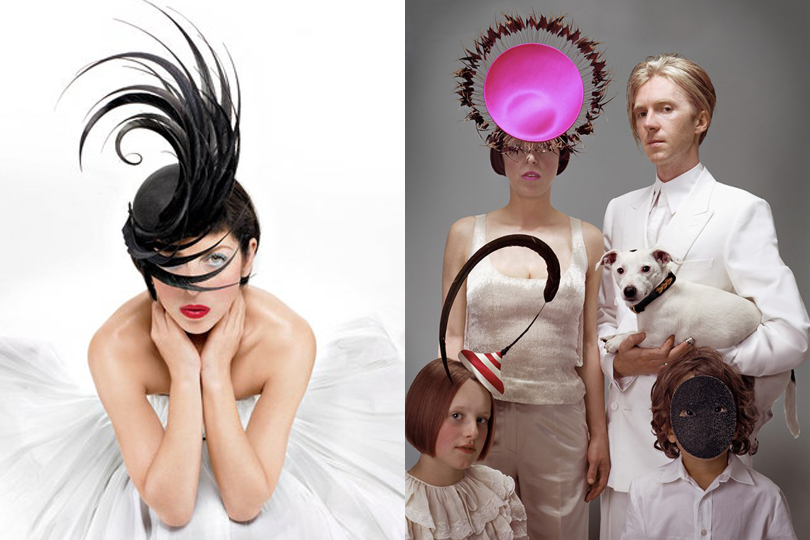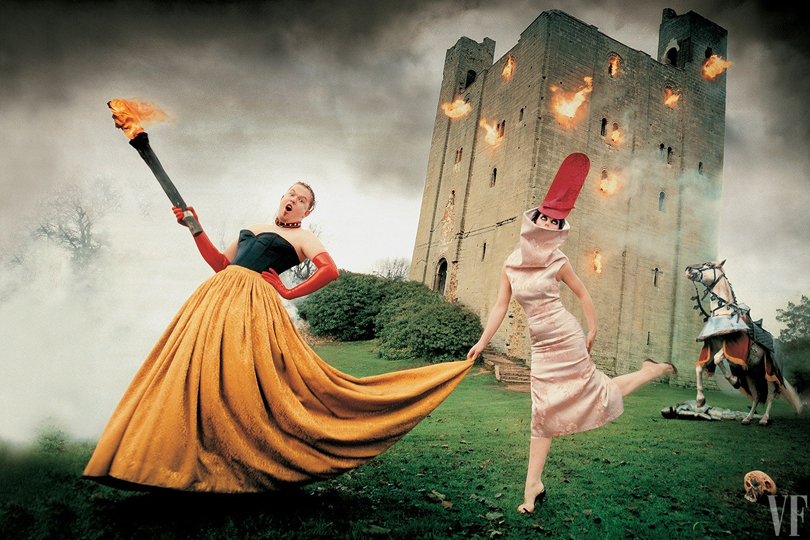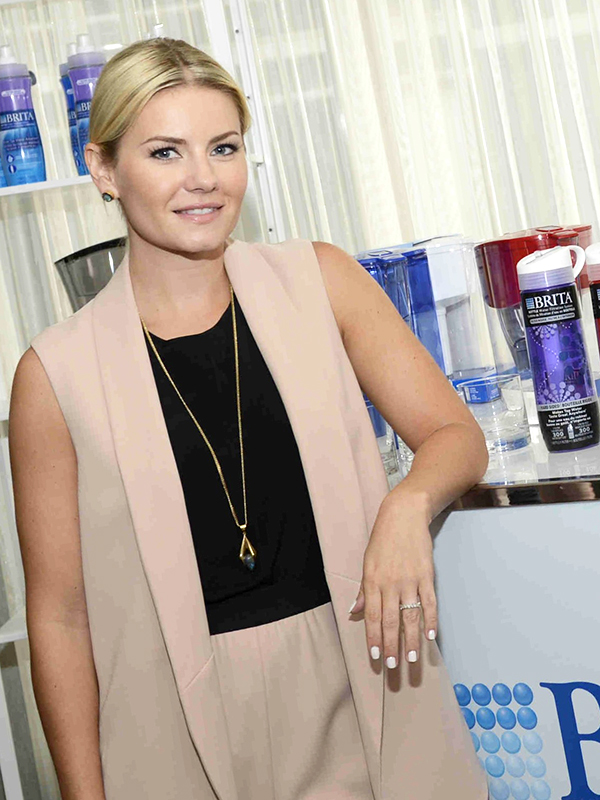Part of an ongoing series of 29Secrets stories, taking a deep dive into the history of legendary beauty products and iconic fashion moments…
By Christopher Turner
Illustration by Michael Hak
She has been described as one of the most influential people in fashion history, serving as both a consultant and muse. Yet even as Isabella Blow (or Issie, as friends knew her) paved the road to success for others, she could never find that road for herself.
Isabella was one of the fashion industry’s most fascinating and complex personalities, a sort of godmother of the fashion world. The fashion editorials she oversaw as an editor and stylist became legendary. But she was perhaps most famous as a talent-spotter and benefactor to young British designers and fashionistas, discovering talents such as the late fashion designer Alexander McQueen, hat designer Phillip Treacy, fashion designer Julien Macdonald, supermodel Stella Tennant, and model and author Sophie Dahl, among many others.
Despite its glamorous overlay, Isabella’s life was filled with drama and depression. Her marriage to British art dealer Detmar Blow was unstable at the best of times and, though she desperately wanted a family, she couldn’t have children of her own. Ultimately her struggles with bipolar depression and self-loathing, and her refusal – or inability – to recognize the seriousness of her condition, led to numerous suicide attempts. Isabella tragically died on May 7, 2007, at the age of just 48, after drinking weedkiller. It was her seventh suicide attempt in 14 months, with tragic parallels to the suicides of her grandfather and her father-in-law, who also poisoned himself.
After her death, the fashion industry came together to celebrate her contribution and legacy, and she was extensively eulogized and analyzed by fashion’s most famous faces, designers and journalists. She was praised for her exquisite taste, wild ideas and much-photographed outfits, which became artistic expressions in themselves. But, it has been argued, many of those who praised her after her death ignored her ongoing pleas for help while she was alive. Here is the tragic real-life story of fashion icon and muse Isabella Blow.
Tragedy ran deep in her aristocratic family
Isabella Delves Broughton was born on November 19, 1958, in Marylebone, London, and grew up in Staffordshire, England, with her two sisters, Julia and Lavinia, and her brother, John. She was the eldest child of Major Sir Evelyn Delves Broughton, a military officer, and his second wife, Helen Mary Shore, a barrister.
The small cottage where Isabella spent her earlier years was within sight of the now boarded-up Doddington, an ancestral castle that sat on 35,000 acres of land in Cheshire and had been in her family since the 14th century. However, her controversial grandfather, Sir Henry “Jock” Delves Broughton, made poor investments and gambled wildly, forcing him to sell off the castle and most of the estate to pay off his mounting gambling debts. Following the sale, he fled to Kenya in 1940 with his much younger wife, Diana, and was tried for the murder of her lover, the Earl of Erroll. Jock was ultimately acquitted of the murder, but couldn’t escape the smears of the press and his peers. He committed suicide in a hotel room in Liverpool in 1942, in what some saw as an admission of guilt. (The story was immortalized in the book and the 1987 film White Mischief.)
As her future husband, Detmar Blow, recalled in his 2010 biography, Blow by Blow, Isabella was convinced she had inherited her depression from her grandfather (she would later base one of her own unsuccessful suicide attempts closely on his successful one), while her love of fashion came from her grandmother, Jock’s first wife, Lady Vera Delves Broughton.
Isabella’s own life was filled with tragedy from an early age. On September 12, 1964, her two-year-old brother John died after falling into a shallow, half-empty pool in the garden while five-year-old Isabella was supposed to be looking after him.
“The nanny was off on holiday,” Detmar explained in Blow by Blow, “and the little boy had been given Heinz Baked Beans for tea.” It was poor digestion, Detmar suggests, and the cold pool water that gave him the fatal shock.
John’s death traumatized Isabella for the rest of her life, and utterly destroyed the family. Her parents never recovered from the loss of their only son and heir, and eventually divorced 10 years later.
“The repercussions of her brother’s death were enormous,” says author and Isabella’s university friend Liza Campbell. “Here she was, the eldest child, but a girl and therefore quite useless. It’s a hangover from the medieval times she loved.”
Years later, Isabella recalled for Vanity Fair: “I can remember everything about it. The smell of the honeysuckle, and him stretched out on the lawn. My mother went upstairs to put her lipstick on.” In a separate interview, she confided to The Guardian journalist Emine Saner that after the death of her brother, her parents lost all interest in the three girls who were still alive.
Isabella’s shocking statement holds up. Shortly after her brother’s death, she and her sisters were sent away to Heathfield boarding school. When she was 14, while she and her sisters were still away at school, they suddenly got the news that their parents were divorcing. Isabella read the news in a letter during lunch hour, and left the dining room in tears. Later, when Helen said goodbye to her children, she organized them outside in the courtyard of the family’s estate in Staffordshire and simply shook their hands farewell. The cold goodbye was just one of the reasons Isabella resented her mother later in life.
Isabella’s relationship with her father and new stepmother wasn’t any better. In fact, when her father died in 1993, he left her a mere £5,000 of his £6 million fortune.
In search of a more fashionable life
After completing her A-levels (an English high school qualification required to go on to higher education) and a secretarial college course, Isabella took odd jobs throughout London, from working in a scone shop to cleaning jobs. In 1979, when she was 21, she moved to New York City to study ancient Chinese art. Along with other adventures along the way (she briefly worked for designer Guy Laroche in Texas as well as married, and divorced, Nicholas Taylor), she befriended Andy Warhol and Jean-Michel Basquiat, and became part of New York’s trendy avant-garde scene. Her friend the musician Bryan Ferry introduced her to Anna Wintour, who was then the fashion director of the US edition of Vogue (Wintour was named editor-in-chief in 1988).
Isabella was hired as Wintour’s assistant in 1982, and the two got along famously. “I loved coming to the office because I never knew what to expect,” recalled Wintour. “One day she’d be a maharaja, the next day a punk, and then she’d turn up as a corporate secretary in a proper little suit and gloves.”
Then-colleague Alexandra Shulman also remembers Isabella’s eclectic sense of style. Shulman recalls the new girl arriving for her first day at Vogue “in thigh-skimming bloomers with hold-up fishnets and a Chanel couture jacket” that stopped traffic.
Isabella stayed at Vogue for four years, eventually also assisting André Leon Talley, another pioneering Vogue editor, but ultimately, she longed to be back in England. So, in 1986, with a recommendation from Wintour, she returned to London to work at Tatler and then The Sunday Times Style magazine.
In 1989, when she was 31, Isabella met 24-year-old Detmar Blow, a barrister and art dealer, and the two developed a bond, particularly over their respective dark family histories. (Detmar’s father, Jonathan Blow, had committed suicide when Detmar was just 14 by drinking the weedkiller Paraquat.) Sixteen days after they met, they were engaged. When they wed at Gloucester Cathedral later that year, on November 19, 1989, Isabella walked down the aisle wearing a medieval-inspired purple velvet dress covered in hand-embroidered trompe l’oeil necklaces and a gold-lace headdress that was created by the then-unknown designer Philip Treacy. It was the beginning of a now-famous fashion relationship.

Spotting talent
The role that Isabella played in the fashion industry was hard to describe. Her formal employment was mostly as a fashion editor and brand consultant, but her greatest asset was her eye for spotting talent.
Philip Treacy was her first find. He was still a student at the Royal College of Art when he stopped by Tatler in 1989 carrying a green crocodile hat he had designed. Recognizing Treacy’s talent, Isabella called the school to track down the young designer, and asked if he could make her a dramatic hat for her upcoming wedding. Treacy did, and Isabella was thrilled…so thrilled that she called him during her honeymoon and said, “Why don’t you come live in my house and make hats?” And so he did.
Isabella established Treacy in her London flat, where he worked on his collections. She soon began wearing his hats, making them a signature part of her flamboyant style.
Her next find would soar to even greater heights under her mentorship. Three years later, in 1992, Isabella went to the prestigious Central Saint Martins College of Art and Design to watch the graduating seniors’ projects (unable to get a seat, she opted to sit on the floor). Lee Alexander McQueen was presenting his graduation collection, Jack The Ripper Stalks His Victims, which was inspired by the tragic stories of Jack The Ripper’s Whitechapel victims. Isabella famously bought the entire collection for £5,000, paying it off in weekly £100 instalments. More importantly, she got on the phone with every fashion contact she’d ever made and raved about the talented young designer.
Treacy was already becoming incredibly successful thanks to Isabella’s mentorship – and when he moved out of her London flat in 1992, McQueen moved in. With Isabella at his side, McQueen opened his own label under the name Alexander McQueen (at Isabella’s suggestion, of course). She continued to champion and mentor him through the early years, ultimately catapulting his career while continuing to help build Treacy’s. She was absolutely devoted to both designers, and initially vice versa.
Other designers, including Julien Macdonald, benefited from her unique mentorship…but she also had an aptitude for spotting models, the two most noteworthy being Sophie Dahl and Stella Tennant. When Isabella was an editor at British Vogue, she spotted Sophie Dahl crying on a Kensington street corner and cast her immediately in an upcoming photo shoot. And she later cast Stella Tennant (who had given Isabella a couple of passport photos in lieu of any professional pictures) in a fashion spread that she styled for the December 1993 issue of British Vogue that was to epitomize British cool. The “Anglo-Saxon Attitude” photo shoot (with famed fashion photographer Steven Meisel) featured Tennant – her eyes ringed by heavy black eyeliner, wearing Alexander McQueen designs, Wolford fishnets and Vivienne Westwood platforms – and it launched Tennant’s extraordinary career.
“No one,” says Wintour, “had an eye like Issie. The more corporate of us look at everything differently than someone like Issie, so whenever I got that phone call [where] Issie said I should see something, I would go.”
Isabella’s business slowly became one of launching incredibly lucrative careers and begging her connected fashion friends to come see, support, photograph, and wear her latest protégés…and then not benefitting financially from all that endless networking. Over time, she became bitter about the success of those she’d helped, McQueen in particular.
Isabella heavily influenced LVMH’s decision to hire McQueen as the head of French luxury fashion house Givenchy in 1996, which came with an enormous paycheque. It was assumed that Isabella would tag along, as designers often took their muses with them in an official capacity. McQueen didn’t. Still, she showed up to his first Givenchy haute couture collection, which he presented in Paris in January 1997. When the collection was trashed in the press, she got to work repairing his image.
McQueen served as Givenchy’s creative director from 1996 to 2001, but never found an official paid position for Isabella. The same when the Gucci Group bought his eponymous label. In 1997, Isabella had lunch with Tom Ford, then head of Gucci, who mentioned that he was looking to make acquisitions to expand the Gucci Group. Isabella suggested he buy McQueen’s label. Gucci Group and McQueen entered into negotiations, and a multi-million-dollar price was agreed upon. But then Blow found out there was no mention of her – and no money for her yet again, despite the fact that she had brokered the deal.
Daphne Guinness, a friend of Isabella’s, stated: “She was upset that Alexander McQueen didn’t take her along when he sold his brand to Gucci. Once the deals started happening, she fell by the wayside. Everybody else got contracts, and she got a free dress.”
“He’s become a multimillionaire,” Isabella once said of McQueen. “He’s got it all stashed away. His nest is all piled up with stuff. Everything is money. And he always says that’s all I ever think about, and that’s unfair. I said to Tom Ford, ‘Buy McQueen.’ It was totally me.
“As my therapist says, the umbilical cord has a price tag on it.”
She wasn’t getting paid for her work behind the scenes, but she was a fashion industry darling, her appearance at fashion shows garnering almost as much attention as the fashions being shown. Isabella was not, by any conventional measure, a beautiful woman, but she dressed her way around it. For example: She once wore a jewel-encrusted lobster on her head, and on another occasion an outfit inspired by Joan of Arc, which included a heavy, oily chain that she dragged behind her. Afterwards, she visited Karl Lagerfeld at his Paris home and dragged the dirty chain all over his plush cream carpets. At a lunch with Nicholas Coleridge, managing director of Condé Nast, she wore a pair of antlers covered in a heavy black lace veil. When he asked how she would be able to eat, she said: “Nicholas, that is of no concern to me whatsoever.”
“I always thought she should’ve started an agency,” says Jeremy Langmead, who is now the editor of British Esquire but once happily shocked the stuffy staff of the London Times by hiring Isabella. “She functioned as an agency; she just didn’t get paid.”
“She was brilliant at finding new things,” said photographer Mario Testino. “But it was hard for her to define her job, and it was hard to find ways to pay her. So you find a designer, or you find the model, but how do you invoice for that?”

The beginning of the end?
Financial struggles and insecurity plagued Isabella all her life, but McQueen’s decision not to compensate her as his career continued to flourish – thanks in part to her – was the beginning of a downward spiral that reinforced her fear of winding up broke and alone. True, she was married and earned an adequate living as a fashion editor, and she made money from lucrative consulting work with a variety of brands including DuPont Lycra, Lacoste and Swarovski. But she was admittedly incompetent when it came to dealing with money. In short, she spent everything she had on clothes and other luxury items.
“She would say, ‘I’m going to be a bag lady, I just know it,’” said Treacy. “She talked about the Marchesa Casati, who lived on a park bench and every time she got money, she spent it on gardenias.”
One of Isabella’s great desires was to have a child, but she and Detmar couldn’t conceive. The couple was, understandably, frustrated at their inability to have a child, which Isabella obsessed over. There were fertility drugs and several – at Isabella’s estimation, eight – attempts at IVF.
“We are like a pair of exotic fruits that cannot breed when placed together,” Isabella once said.
Her marriage suffered. Detmar had an affair with lesbian writer Stephanie Theobald, while Isabella went off to Venice and had a fling with a gondolier. Later, their reconciliation was more bitter than sweet.
She was struggling and would tell anyone who asked that she was morbidly depressed. She tried all sorts of therapy, even electric shock therapy, and willingly went to any private mental health clinic suggested to her. Friends were concerned, but they also grew tired of Isabella’s macabre side, never knowing if she was being serious.
“People say, ‘How are you?’ and you say, ‘Fabulous,’” said Treacy. “But not Isabella. She’d say, ‘I’m suicidal.’” As someone else put it, “Someone finally said, ‘Look, Issie, if you really mean to kill yourself, there’s a pool out back – go drown!’”
“One day she was crying,” Detmar recalled, “and she took this crumpled-up tissue and showed it to me and said, ‘This is me. This is what I am.’ Rupert Everett was there, and he said, ‘No, Issie. That’s a handkerchief.’ And it was good of Rupert to say that, but it was never enough.”
Isabella began telling her close friends that she intended to kill herself in March 2006. In fact, she told everyone, including the fashion press. In a way, talk of suicide was offered conversationally, and was difficult to separate from her wit and sense of humour.
Friends may have struggled to take her seriously, but the tragic truth is that in the 14 months leading up to her death, Isabella attempted to end her own life seven different times. Her first suicide attempt was an overdose shortly after the Milan shows on March 20. After that, she went willingly to another private clinic, but a week later she took a taxi ride around the family estate at Doddington before checking into a hotel and taking an overdose of paracetamol pills. Two weeks after she was released from that hospital stay, she took Detmar’s car keys in the middle of the night and crashed her car into a Tesco in another attempt to end her life. “I always hated Tesco,” she told Detmar disdainfully afterwards.
Her fourth attempt was three weeks later, in June 2006, when she threw herself off Hammersmith Flyover (a bridge nicknamed Suicide Bridge) in London. She survived the jump, but shattered numerous bones in her legs and feet. Those injuries condemned her to flat shoes for the remainder of her life: another blow to the self-esteem of a woman who was never without her sky-high Manolo Blahnik heels. The seriousness of the incident would come to signal the start of a steeper phase in her decline.
She did try to get psychiatric help, but it didn’t seem to make a difference. There were more attempts to take her own life (an attempt to drown herself in a lake, and an overdose while on a beach in India), more drugs to fight her bipolar disorder and more stays at private mental health clinics.
Then, on top of all that, after years of unsuccessful fertility treatments, Isabella was diagnosed with ovarian cancer. That, her family and friends conclude, was the final straw. On May 5, 2007, Isabella drank a bottle of Paraquat, the same poison that her father-in-law had used to kill himself 30 years earlier. Isabella’s sister Lavinia found her curled up on the floor of the bathroom and called an ambulance. On the way to the hospital, Isabella admitted to Lavinia what she’d done. “She was worried that she didn’t drink enough,” Lavinia said at the inquest.
The next day, doctors told Isabella that she would not recover, that she had in fact drunk 10 times too much. They could not say how long it would take, perhaps as long as three weeks, but the process was underway and could not be reversed. Taking the news in stride, she changed out of her hospital gown and into a vintage silver lamé shirt by Giles Deacon, then called those closest to her to relay her wishes and what she wanted them to have – not mentioning that she knew she was dying.
After two days in hospital, Isabella’s desire to die was finally realized. She passed away peacefully in her sleep a few minutes after five in the morning on May 7, 2007. The news came on the morning of the Met’s annual Costume Institute Gala in celebration of the “Poiret: King Of Fashion” exhibition.
Recognition…after her death
News of Isabella’s death at the age of 48 was shocking but not surprising to many…although many were confused. Detmar initially told the press his wife had died of cancer, which was not true. Later that year, on December 5, 2007, the coroner’s office confirmed that Isabella Blow had killed herself by taking a fatal dose of a poison.
Her funeral was held on May 15, 2007, at Gloucester Cathedral – the same church where she had wed Detmar. She was buried wearing a pheasant feathered Philip Treacy hat and an elaborate embroidered Alexander McQueen coat. Rupert Everett and actress Joan Collins delivered eulogies, while opera singer Charles Eliasch sang. Isabella’s protégés – including Lee Alexander McQueen, Philip Treacy, Julien Macdonald and Sophie Dahl – were all in attendance. Later that year, on September 18, 2007, a memorial service was held in the Guards’ Chapel in London where Anna Wintour and journalist Geordie Greig spoke.
Five months after her death, on October 5, 2007, McQueen presented his spring/summer 2008 collection, La Dame Bleue, in Paris, which was both dedicated to and inspired by Isabella, with brightly coloured clothes and plenty of feathers. Fittingly, the collection included numerous pieces courtesy of fellow protégé Treacy.
The first time McQueen spoke publicly of Isabella’s death was in a June 2008 interview with W Magazine. He insisted that her death had given him a reason to live. “I learned a lot from her death,” he said. “I learned a lot about myself. [I learned] that life is worth living. Because I’m just fighting against it, fighting against the establishment. She loved fashion, and I love fashion, and I was just in denial.” (He said this referring to his particularly bleak collection, In Memory of Elizabeth Howe, Salem 1692, based on the Salem witch trials.)
Despite his stated comments about Isabella, life and death, Lee Alexander McQueen would kill himself in the early hours of February 11, 2010, less than three years after Isabella. At his inquest, his doctor – the same one Isabella had been seeing when she died – said McQueen had tried to overdose twice before, in May and July of 2009.
After Isabella’s death, there were coffee table books, biographies, talk of a movie and more. The Somerset House in London (a multipurpose venue that “connects creativity and the arts with wider society”) even organized an exhibition titled “Isabella Blow: Fashion Galore!” in her memory. But as Treacy told The Telegraph, things were different when she was still alive: “She was never feted while she was alive.… She supported the careers of many young people who didn’t stand a chance without her, yet she never won a single award. It’s all very well them feting her now and going on about how wonderful and brilliant she was. There will be people at that exhibition who laughed at her when she was alive.”
Hopefully she’s laughing now.
![]()
Want more? You can read other stories from our The Story Of series right here.










